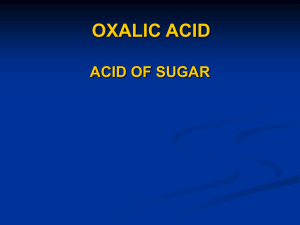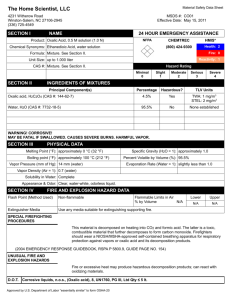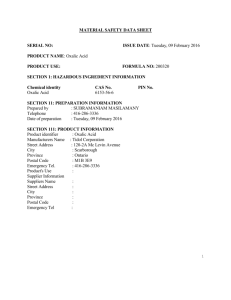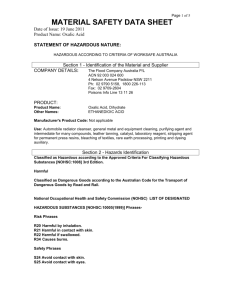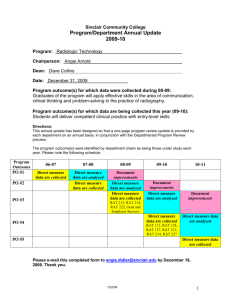MATERIAL SAFETY DATA SHEET DECK WASH CONCENTRATE
advertisement
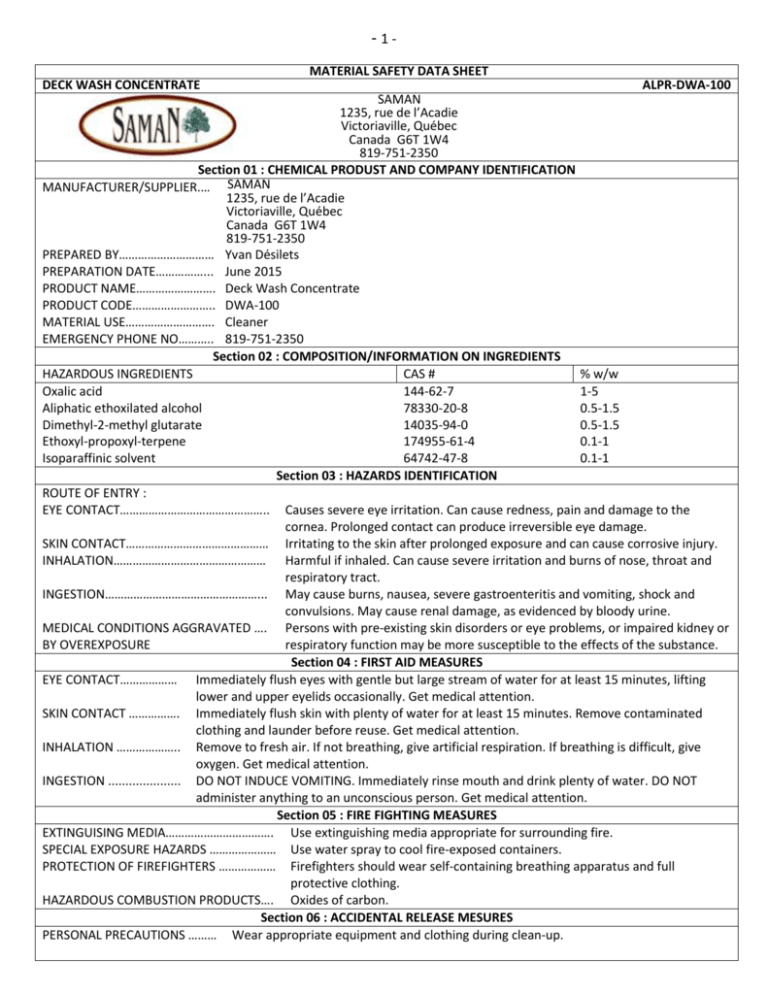
-1MATERIAL SAFETY DATA SHEET DECK WASH CONCENTRATE ALPR-DWA-100 SAMAN 1235, rue de l’Acadie Victoriaville, Québec Canada G6T 1W4 819-751-2350 Section 01 : CHEMICAL PRODUST AND COMPANY IDENTIFICATION MANUFACTURER/SUPPLIER.… SAMAN 1235, rue de l’Acadie Victoriaville, Québec Canada G6T 1W4 819-751-2350 PREPARED BY………………………… Yvan Désilets PREPARATION DATE……………... June 2015 PRODUCT NAME……………………. Deck Wash Concentrate PRODUCT CODE…………………….. DWA-100 MATERIAL USE………………………. Cleaner EMERGENCY PHONE NO……….. 819-751-2350 Section 02 : COMPOSITION/INFORMATION ON INGREDIENTS HAZARDOUS INGREDIENTS CAS # % w/w Oxalic acid 144-62-7 1-5 Aliphatic ethoxilated alcohol 78330-20-8 0.5-1.5 Dimethyl-2-methyl glutarate 14035-94-0 0.5-1.5 Ethoxyl-propoxyl-terpene 174955-61-4 0.1-1 Isoparaffinic solvent 64742-47-8 0.1-1 Section 03 : HAZARDS IDENTIFICATION ROUTE OF ENTRY : EYE CONTACT……………………………………….. Causes severe eye irritation. Can cause redness, pain and damage to the cornea. Prolonged contact can produce irreversible eye damage. SKIN CONTACT……………………………………… Irritating to the skin after prolonged exposure and can cause corrosive injury. INHALATION………………………………………… Harmful if inhaled. Can cause severe irritation and burns of nose, throat and respiratory tract. INGESTION…………………………………………... May cause burns, nausea, severe gastroenteritis and vomiting, shock and convulsions. May cause renal damage, as evidenced by bloody urine. MEDICAL CONDITIONS AGGRAVATED …. Persons with pre-existing skin disorders or eye problems, or impaired kidney or BY OVEREXPOSURE respiratory function may be more susceptible to the effects of the substance. Section 04 : FIRST AID MEASURES EYE CONTACT……………… Immediately flush eyes with gentle but large stream of water for at least 15 minutes, lifting lower and upper eyelids occasionally. Get medical attention. SKIN CONTACT ……………. Immediately flush skin with plenty of water for at least 15 minutes. Remove contaminated clothing and launder before reuse. Get medical attention. INHALATION ……………….. Remove to fresh air. If not breathing, give artificial respiration. If breathing is difficult, give oxygen. Get medical attention. INGESTION ..................... DO NOT INDUCE VOMITING. Immediately rinse mouth and drink plenty of water. DO NOT administer anything to an unconscious person. Get medical attention. Section 05 : FIRE FIGHTING MEASURES EXTINGUISING MEDIA……………………………. Use extinguishing media appropriate for surrounding fire. SPECIAL EXPOSURE HAZARDS ………………… Use water spray to cool fire-exposed containers. PROTECTION OF FIREFIGHTERS ……………… Firefighters should wear self-containing breathing apparatus and full protective clothing. HAZARDOUS COMBUSTION PRODUCTS…. Oxides of carbon. Section 06 : ACCIDENTAL RELEASE MESURES PERSONAL PRECAUTIONS ……… Wear appropriate equipment and clothing during clean-up. -2ENVIRONMENTAL PRECAUTIONS……………………….. METHODS FOR CLEAN UP ……… Prevent from entering into soil, ditches, sewers, waterways and/or groundwater. Consult local authorities. Absorb with an inert absorbent. Sweep up and place in an appropriate closed container. Clean up residual material by washing area with water. Collect washings for disposal. Decontaminate tools and equipment following clean up. Section 07 : HANDLING AND STORAGE HANDLING PROCEDURES …………... Avoid contact with skin and eyes. Use in well ventilated area. Do not breathe vapors. As with any chemical, wash hands thoroughly with soap and water after handling. STORAGE NEEDS…………………………. Keep container closed when not in use. Store in a cool well-ventilated area Section 08 : EXPOSURE CONTROL/PERSONAL PROTECTION ENGINEERING CONTROLS…… Good general ventilation. Local exhaust ventilation is suggested for use in enclosed or confined places. RESPIRATORY……………………… If ventilation is not sufficient, wear an approved respirator. EYE PROTECTION ……………….. Wear approved safety goggles. SKIN PROTECTION………………. Wear suitable protective clothing. HYGIENE MEASURES ………… Always observe good personal hygiene measures, such as washing after handling the material and before eating, drinking and/or smoking. Routinely wash work clothing and protective equipment to remove contaminants. Section 09 : PHYSICAL AND CHEMICAL PROPERTIES PHYSICAL STATE………………………………… liquide ODOUR……………………………………………… mild SPECIFIC GRAVITY (WATER=1)…………… 1.01-1.02 VISCOSITY FORD CUP #4 (SECONDS)….. not available PH…………………………………………………...... not available % VOLATILE PER WEIGHT…………………… 95 ± 1 BOILING POINT (°C)……………………………. >100 °C (212 °F) FREEZING POINT (°C)………..……………….. not available VAPOR PRESSURE (mm Hg)……………….. not available VAPOR DENSITY (AIR=1)…………………….. not available EVAPORATION RATE………………………….. not available VOC ………………………………………………… 0.4 % SOLUBILITY IN WATER……………………….. miscible Section 10 : STABILITY AND REACTIVITY CHEMICAL STABILITY…………………………………………. Stable under normal handling and storage conditions. CONDITIONS TO AVOID …………………………………….. Excessive heat. Incompatible materials. INCOMPATIBLE MATERIALS .................................. Alkalis, chlorites, hypochlorites, oxidizing agents, furfuryl alcohol and silver compounds. HAZARDOUS PRODUCTS OF DECOMPOSITION…… Oxides of carbon. HAZARDOUS POLYMERIZATION…………………………. Will not occur. Section 11 : TOXICOLOGICAL INFORMATION OXALIC ACID LD 50………………………………………………………………. Rat (oral) : 7500 mg/kg Rabbit (dermal) : 2000-20000 mg/kg ALIPHATIC ETHOXILATED ALCOHOL LD 50………………………………………………………………. Rat (oral) : > 2000 mg/kg Rabbit (dermal) : > 2000 mg/kg DIMETHYL-2-METHYL GLUTARATE LD 50………………………………………………………………. Rat (oral) : > 2000 mg/kg ETHOXYL-PROPOXYL-TERPENE Harmful. No test data found for this product. -3ISOPARAFFINIC SOLVENT LD 50………………………………………………………………. Rat (oral) : > 5000 mg/kg Rat (dermal) : 2000-4000 mg/kg Section 12 : ECOLOGICAL INFORMATION OXALIC ACID LC 50………………………………………………………………. Fish (Bluegill) : 4000 mg/l (24 h) Fish (Goldfish): 1000 ppm (0.5 h) Fish (Trout): 100 ppm (0.3 h) Persistence and degradability: Possibly hazardous short term degradation products are not likely. However, long term degradation products may arise. ALIPHATIC ETHOXILATED ALCOHOL Ecotoxicity : Toxic to aquatic life. Harmful to aquatic life with long lasting effects. LC 50 ………………………………………………………………. Fish: 1-10 mg/l (96 h) EC 50 ……………………………………………………………… Algae: 1-10 mg/l (72 h) Crustacea (Daphnia): 1-10 mg/l (48 h) Persistence and degradability: Readily biodegradable. DIMETHYL-2-METHYL GLUTARATE No test data found for this product. ETHOXYL-PROPOXYL-TERPENE Ecotoxicity : The following data is for similar or related products. LC 50………………………………………………………………. Mysidopsis bahia (saltwater mysid) : 12 mg/l (96 h) Persistence and degradability: Not readily biodegradable. ISOPARAFFINIC SOLVENT Ecotoxicity : Toxic to aquatic life. LC 50………………………………………………………………. Oncorhynchus mykiss (Rainbow trout) : 2900 mg/l (96 h) Aquatic invertebrate (Daphnia magna) : 1400 mg/l (48 h) Persistence and degradability: No data available. Section 13 : DISPOSAL CONSIDERATIONS WASTE DISPOSAL…. Disposal in accordance with applicable regional, national and local laws and regulations. Section 14 : TRANSPORT INFORMATION TRANSPORT OF DANGEROUS GOODS REGULATIONS U.S. Department of Transportation (DOT) Not regulated Canadian Transportation of Dangerous Goods ( TDG ) Not regulated Section 15 : REGULATORY INFORMATION OXALIC ACID WHMIS CLASSIFICATION…….. D1B, toxic materials E, corrosive material Section 16 : OTHER INFORMATION To the best of our knowledge, the information contained herein is accurate. However, neither the above named supplier nor any of its subsidiaries assumes any liability for the accuracy or completeness of the information contained herein. Final determination of suitability of any material is the sole responsibility of the user. All materials may present unknown hazards and should be used with caution. Although certain hazards are described herein, we cannot guarantee that these are the only hazards that exist.

